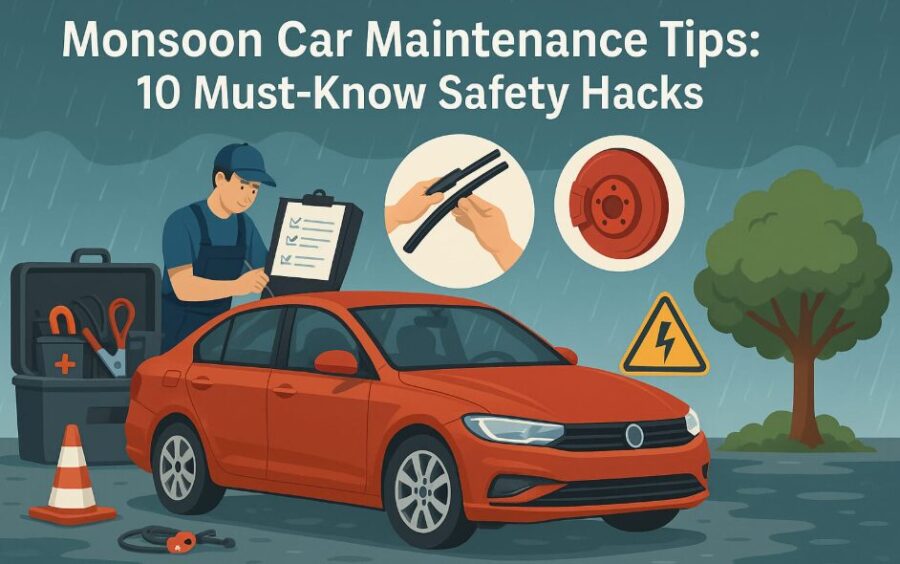While the initial rains of monsoon touch the dry land, there is something enchanting in the air—the aroma of new rain, the refreshing air, and the time of greenery. But while we love this seasonal change, your automobile may not be that thrilled. The monsoon season delivers more than romance—it delivers muddy roads, water-logged streets, low visibility, and surprise breakdowns. Whether you are a car owner in India, you recognize that this isn’t a season—it’s a trial on your vehicle.
Your vehicle, just like us, requires a bit of special care and guarding now. And by taking only a few intelligent precautions, you can make your vehicle cruise through the monsoon season sans any glitches. Here are 10 must-follow tips to ensure your vehicle monsoon-proof and in top shape.
1. Give Your Car a Pre-Monsoon Check-Up
Get your vehicle checked by an expert before the onset of the heavy rains. A general service check-up must cover brakes, battery, engine oil, suspension, and coolant. Early signs of malfunction can be caught by mechanics, and you will be spared costly repairs down the line. It is your car’s medical check-up prior to the main rainstorm.
2. Replace Old Wiper Blades
Ever been caught in a downpour with wipers that just smear the water instead of clearing it? It’s a nightmare. Wipers are often the most neglected part of the car until it starts raining. Replace them if they squeak, leave streaks, or have cracked rubber. Also, top up the windshield washer fluid with a cleaning solution to improve visibility.
3. Check and Maintain Tyre Health
Monsoon roads are slick, slippery, and sometimes treacherous. Good tyres are your first line of defense. Ensure the tread depth is at least 2-3 mm and the tyre pressure is balanced. Under-inflated tyres reduce grip, while over-inflated ones can be risky on wet roads. If your tyres are balding, don’t think twice—get them replaced.
4. Test the Brakes – Then Test Again
Brakes are probably the most important part when it rains. Long braking distances mean wet roads. Have the brake pads, discs, and fluid tested. If they squeak or if you feel a lag in reaction, have them inspected right away. Also, drive slowly and softly on wet roads to prevent skidding—easy and steady does it.
5. Seal All Leaks and Clean the Drainage Channels
Vehicles have countless small gaps and drain holes. Monsoon discovers all of them. Inspect the rubber beading on the windows and doors for gaps or cracks. Clean out drainage holes around the windshield and doors, because clogging up is what can cause water to flood into the cabin. You don’t want to have to contend with a stinky interior or, worse yet, water damage to electrical components.
6. Guard the Electrical System
Water and electricity don’t mix—and vehicles are equipped with sensitive electronics. Ensure that there are no exposed wires. Avoid driving through flooded streets to avoid short circuits. If water enters your engine or battery, it can be lethal to the vehicle. If you have to drive through standing water, take it slow, and when you emerge, tap your brakes gently to dry them.
7. Wax It Right: Exterior Paint Protection
A good coat of wax is a barrier between your paint and acidic rainwater. Rain carries pollutants that have a tendency to cling to your car and rust or bleach. Waxing not only protects, but it’s also easier to brush off mud splatters later.
Bonus: Your car looks great even on gloomy days!
8. Underbody is Clean and Rust-Free
The underbody is weakest during monsoon since they are constantly in contact with water, mud, and slush. Get an anti-rust coating if your vehicle is several years old. Regular cleaning of the underbody, particularly after long drives on wet roads, can help a lot in avoiding corrosion.
9. Have a Monsoon Emergency Kit
Yes, you’ve got a first-aid kit. But monsoon demands a little more. Store a flashlight, jumper cables, tow rope, raincoat, umbrella, and a microfiber cloth in your vehicle. A phone charger and power bank can also be lifesavers if you’re stranded. Trust us, when the rain gets ugly, you’ll be thanking yourself for packing smart.
10. Park Smart – Steer Clear of Trees and Low-Lying Areas
This may seem obvious, but it’s easily forgotten. Don’t park under ancient trees (hanging branches are a standard feature of storm damage) and never park in basements or flood-prone low-lying areas. It takes just one intense downpour to soak your vehicle and ruin the engine, seats, and interiors.
Always park in raised, well-drained spots.
Final Thoughts: Don’t Just Drive—Drive Prepared
Monsoon isn’t just a season—it’s an adventure. The roads may get rough, but with proper precautions, your vehicle can ride it all like a pro. These 10 tips are more than preventive maintenance—they’re about safety, peace of mind, and making sure you ride the rains without worry.
So, before the heavens rain down, roll up your sleeves, treat your car the way it should be treated, and prepare for anything the clouds may bring. Because when you’re ready, even the stormiest ride can turn out to be a great experience.
Happy (and safe) monsoon driving!

